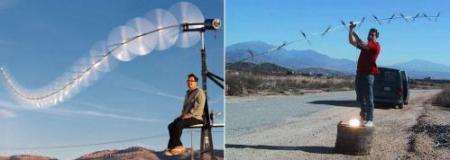May 26, 2008 weblog
Scalable wind turbine might fit on your roof

When you think of wind power, you probably picture gigantic wind turbines spinning gracefully in the middle of large open areas.
But an entrepreneur from Fullerton, California, has invented a new wind turbine design that is smaller, scalable, and could potentially fit on the roofs of homes like a long satellite antenna.
Rather than a single giant rotor with 50-foot-long blades, Doug Selsam´s "Sky Serpent" design uses several small rotors attached to a single shaft. By placing the rotors in precise positions and angles, each rotor can harvest its own wind, and avoid simply stealing the wake from the adjacent rotor. The entire turbine is hooked up to a single generator, which produces about the same amount of power as a turbine that uses 10 times as much blade material, Selsam says.
The shaft that holds the rotors can vary in length, and use any number and size of rotors, depending on its application. The rotors can even be mounted on poles that are light enough to be hand-held or attached to the roof of a house. Using ten 18-inch rotors, for example, one Sky Serpent model can generate between 100 and 400 watts, depending on wind speed.
Selsam has been working on the Sky Serpent design since 1999, with support from a $75,000 grant from the California Energy Commission. Working out of his garage and doing tests in a makeshift wind tunnel, he´s built a seven-rotor turbine that can generate 3,000 watts, as well as a dual-rotor turbine that generates 2,000 watts. He´s already sold 20 of the 2,000-watt devices to homeowners.
Another 3,000-watt prototype uses 25 rotors, where the shaft is attached to the ground at one end and held in the sky by a balloon at the other. In another concept, the turbine can float near the surface of water, its shaft and propellers extended in the air over the open ocean.
In the early ´80s, Selsam attended classes at but never graduated from the University of California at Irvine. However, his multi-rotor designs have received positive feedback from former General Electric turbine tester Brent Scheibel, who now runs a wind-testing facility in Tehachapi, California.
"Doug´s idea is one of the very, very few that I´ve seen that actually has a strong chance of making strides into the commercial world," Scheibel said in an interview with Popular Science.
As the wind turbine industry grows by more than 40 percent per year, Selsam hopes that the simple Sky Serpent design will simplify the manufacturing, transportation, and installation compared with conventional turbines - as well as provide more energy and be less of an eyesore.
via: Popular Science, Tech.Blorge.com, and SpeakerFactory.net





















